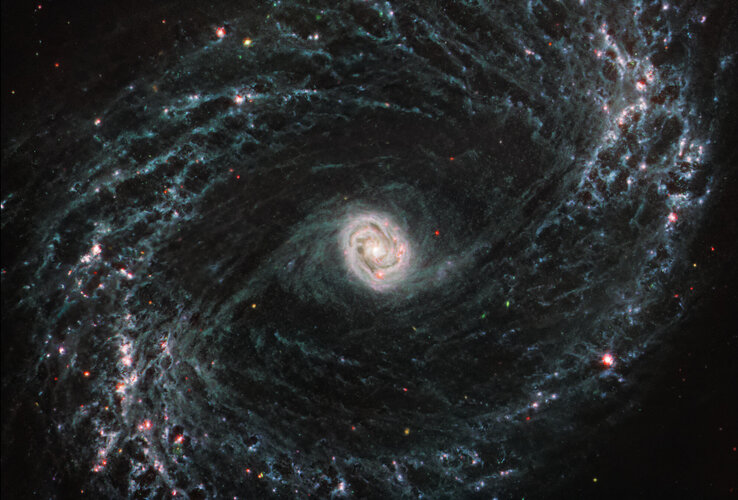What is a UFO? The US shot down three mysterious objects as interest and concern increase over unidentified craft
Thursday, 16 February 2023 18:20
On the heels of the Feb. 4, 2023, shooting down of a Chinese balloon suspected of spying on the U.S., American fighter jets have shot down three additional objects in or near U.S. airspace.
When the media asked Glen VanHerck, the Air Force general responsible for overseeing North American airspace, about these events, he refused to rule out extraterrestrial forces at play. Other military officialslater clarified that otherworldly origins aren't a serious consideration, but the comment highlighted the U.S. government's lack of knowledge about these objects.
As a space policy expert, I'm often confronted with questions about UFOs and little green people. However, as these recent episodes have shown, a UFO is far more likely to be human-made, rather than originating from some faraway place in the universe.
An extremely lightweight fission rocket could reach the solar gravitational lens in 15 years
Thursday, 16 February 2023 18:04
Novel propulsion ideas for moving around space seem like they're a dime a dozen recently. Besides the typical argument between solar sails and chemical propulsion lies a potential third way—a nuclear rocket engine. While we've discussed them here at UT before, NASA's Institute of Advanced Concepts has provided a grant to a company called Positron Dynamics for the development of a novel type of nuclear fission fragment rocket engine (FFRE). It could strike the balance between the horsepower of chemical engines and the longevity of solar sails.
FFREs are not a new concept in themselves, but many have massive technical hurdles to overcome before they can be considered useful. Their advantages, such as high specific impulse and extremely high power density, are offset by their disadvantages, such as requiring a complicated form of plasma levitation.
Opinion | A new leap in opportunities for the exploration and utilization of space
Thursday, 16 February 2023 17:56
Although the development of the SLS was driven by launch needs for human exploration of the Moon and Mars, it provides a much greater level of capability for the broader spacefaring community.
Webb reveals intricate networks of gas and dust in nearby galaxies
Thursday, 16 February 2023 15:00
Researchers using the NASA/ESA/CSA James Webb Space Telescope are getting their first look at star formation, gas, and dust in nearby galaxies with unprecedented resolution at infrared wavelengths. The data have enabled an initial collection of 21 research papers which provide new insight into how some of the smallest-scale processes in the Universe — the beginnings of star formation — impact the evolution of the largest objects in our cosmos: galaxies.
Chinese rocket firm Space Pioneer set for first launch
Thursday, 16 February 2023 12:16
HELSINKI — Commercial launch firm Space Pioneer announced new funding this week and will soon take a shot at becoming China’s first such company to reach orbit with a liquid propellant rocket.
Webb uncovers new details in Pandora's Cluster
Thursday, 16 February 2023 11:46 Astronomers have revealed the latest deep field image from NASA's James Webb Space Telescope, featuring never-before-seen details in a region of space known as Pandora's Cluster (Abell 2744). Webb's view displays three clusters of galaxies - already massive - coming together to form a megacluster. The combined mass of the galaxy clusters creates a powerful gravitational lens, a natural magnifica
Astronomers have revealed the latest deep field image from NASA's James Webb Space Telescope, featuring never-before-seen details in a region of space known as Pandora's Cluster (Abell 2744). Webb's view displays three clusters of galaxies - already massive - coming together to form a megacluster. The combined mass of the galaxy clusters creates a powerful gravitational lens, a natural magnifica NASA study seeks to understand impact effects on Mars rocks
Thursday, 16 February 2023 11:46 A NASA study describes how rocks could have been "shocked" and changed by meteorite impacts, once frequent on ancient Mars. This will improve our analysis of rock samples collected from the Red Planet.
"Because we're counting on these samples to reveal a record of Mars' geologic past, it would be important for us to understand if and how the rocks have been altered," said Dr. Svetlana Shko
A NASA study describes how rocks could have been "shocked" and changed by meteorite impacts, once frequent on ancient Mars. This will improve our analysis of rock samples collected from the Red Planet.
"Because we're counting on these samples to reveal a record of Mars' geologic past, it would be important for us to understand if and how the rocks have been altered," said Dr. Svetlana Shko SpaceDaily Streamlines Imaging Process with ChatGPT's Technology
Thursday, 16 February 2023 11:46 SpaceDaily, a leading news organization covering space exploration, astronomy, and technology, has implemented ChatGPT's technology, along with simple rules lists and innovative software development, to streamline its imaging process.
The combination of these technologies has enabled SpaceDaily to generate filenames for image files based on their captions and vice versa, while also enablin
SpaceDaily, a leading news organization covering space exploration, astronomy, and technology, has implemented ChatGPT's technology, along with simple rules lists and innovative software development, to streamline its imaging process.
The combination of these technologies has enabled SpaceDaily to generate filenames for image files based on their captions and vice versa, while also enablin SpaceX halts plans to convert oil rigs into floating offshore launch pads
Thursday, 16 February 2023 11:46 After speaking at the Federal Aviation Administration Commercial Space Transportation Conference on February 8, President and COO of SpaceX, Gwynne Shotwell told reporters that SpaceX has abandoned their plans for floating Starship launch platforms.
"We bought them. We sold them. They were not the right platform," she said.
SpaceX acquired two former deepwater oil drilling rigs in 20
After speaking at the Federal Aviation Administration Commercial Space Transportation Conference on February 8, President and COO of SpaceX, Gwynne Shotwell told reporters that SpaceX has abandoned their plans for floating Starship launch platforms.
"We bought them. We sold them. They were not the right platform," she said.
SpaceX acquired two former deepwater oil drilling rigs in 20 China's space station experiments pave way for new space technology
Thursday, 16 February 2023 11:46 Multiple engineering experiments are currently underway, or poised to begin, at a cabinet on China's space station which is in a near-Earth orbit. These experiments aim to acquire know-how that can support more experimental possibilities and human survival in outer space.
The Space Basic Experiment Cabinet mounted on the country's space lab module Mengtian is carrying its first group of fi
Multiple engineering experiments are currently underway, or poised to begin, at a cabinet on China's space station which is in a near-Earth orbit. These experiments aim to acquire know-how that can support more experimental possibilities and human survival in outer space.
The Space Basic Experiment Cabinet mounted on the country's space lab module Mengtian is carrying its first group of fi Upsurge in rocket launches could impact the ozone layer
Thursday, 16 February 2023 11:46 University of Canterbury (UC) researchers have summarised the threats that future rocket launches would pose to Earth's protective ozone layer, in a new review article published in the Journal of the Royal Society of New Zealand.
The ozone layer, which protects life on Earth from harmful ultraviolet (UV) rays from the sun, was severely damaged in the 1980s and 1990s due to chlorofluorocarb
University of Canterbury (UC) researchers have summarised the threats that future rocket launches would pose to Earth's protective ozone layer, in a new review article published in the Journal of the Royal Society of New Zealand.
The ozone layer, which protects life on Earth from harmful ultraviolet (UV) rays from the sun, was severely damaged in the 1980s and 1990s due to chlorofluorocarb Brain changes in fighter pilots may cast light on astronauts during space travel
Thursday, 16 February 2023 11:46 One cannot explore the profound mysteries of space without being changed by it. This is the message underlying a new study in Frontiers in Physiology. The study examined the brains of F16 fighter pilots, which have a lot in common with those of astronauts in terms of adapting to altered gravity levels and rapidly processing conflicting sensory information. MRI scans revealed that pilots with mor
One cannot explore the profound mysteries of space without being changed by it. This is the message underlying a new study in Frontiers in Physiology. The study examined the brains of F16 fighter pilots, which have a lot in common with those of astronauts in terms of adapting to altered gravity levels and rapidly processing conflicting sensory information. MRI scans revealed that pilots with mor Two crews set for Tiangong station in '23
Thursday, 16 February 2023 11:46 China will launch two crews to work on its Tiangong space station this year, according to the China Manned Space Agency.
The agency published schedules for the Shenzhou XVI and XVII mission crews on Wednesday, saying that the Shenzhou XVI team will leave for the Tiangong station in May while their counterparts in the Shenzhou XVII mission will fly to the massive orbiting outpost in October
China will launch two crews to work on its Tiangong space station this year, according to the China Manned Space Agency.
The agency published schedules for the Shenzhou XVI and XVII mission crews on Wednesday, saying that the Shenzhou XVI team will leave for the Tiangong station in May while their counterparts in the Shenzhou XVII mission will fly to the massive orbiting outpost in October Hope probe to move to a new Mars orbit and observe deimos
Thursday, 16 February 2023 11:46 Celebrating our second year orbiting the red Planet, the Emirates Mars Mission 'Hope Probe', the first Arab-led planetary exploration mission, is transitioning to a new orbit. The orbital transfer will allow the Hope Probe to fly within approximately 150 Km and capture unprecedented data on Deimos, the smaller and outermost of the two natural satellites of Mars.
The new historical move wil
Celebrating our second year orbiting the red Planet, the Emirates Mars Mission 'Hope Probe', the first Arab-led planetary exploration mission, is transitioning to a new orbit. The orbital transfer will allow the Hope Probe to fly within approximately 150 Km and capture unprecedented data on Deimos, the smaller and outermost of the two natural satellites of Mars.
The new historical move wil Lunar Resources and Wood selected by NASA to study building a pipeline on the Moon
Thursday, 16 February 2023 11:46 Lunar Resources, the pioneering space industrial company, and Wood, a global leader in consulting and engineering with market-leading expertise in terrestrial pipeline transportation systems, have been awarded a grant by NASA's Innovative Advanced Concepts (NIAC) program. This award funds a feasibility study for the Lunar South Pole Oxygen Pipeline (LSPoP), a pipeline at the South Pole of the Mo
Lunar Resources, the pioneering space industrial company, and Wood, a global leader in consulting and engineering with market-leading expertise in terrestrial pipeline transportation systems, have been awarded a grant by NASA's Innovative Advanced Concepts (NIAC) program. This award funds a feasibility study for the Lunar South Pole Oxygen Pipeline (LSPoP), a pipeline at the South Pole of the Mo 
